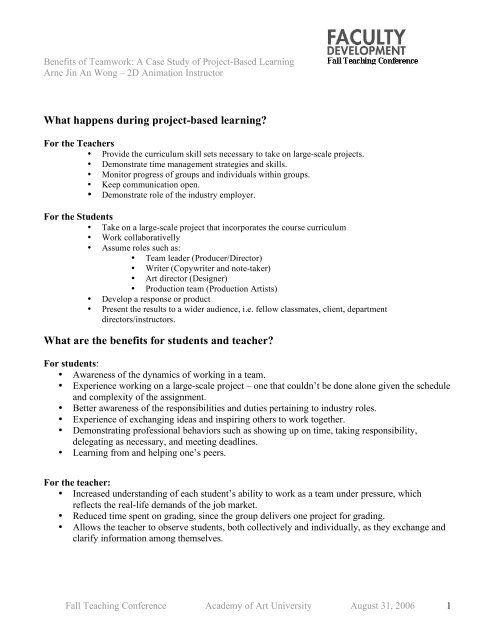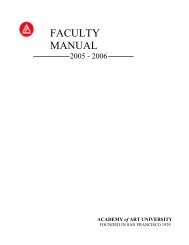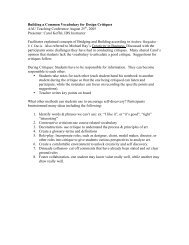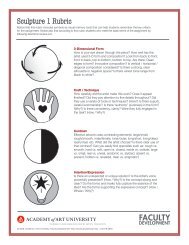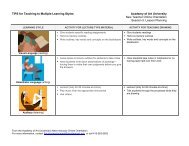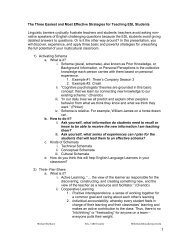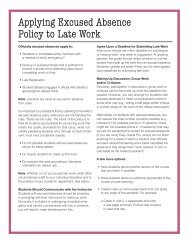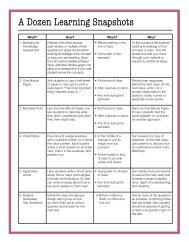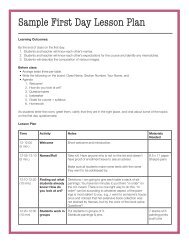What happens during project-based learning? - Academy of Art ...
What happens during project-based learning? - Academy of Art ...
What happens during project-based learning? - Academy of Art ...
Create successful ePaper yourself
Turn your PDF publications into a flip-book with our unique Google optimized e-Paper software.
Benefits <strong>of</strong> Teamwork: A Case Study <strong>of</strong> Project-Based Learning<br />
Arne Jin An Wong – 2D Animation Instructor<br />
<strong>What</strong> <strong>happens</strong> <strong>during</strong> <strong>project</strong>-<strong>based</strong> <strong>learning</strong>?<br />
For the Teachers<br />
• Provide the curriculum skill sets necessary to take on large-scale <strong>project</strong>s.<br />
• Demonstrate time management strategies and skills.<br />
• Monitor progress <strong>of</strong> groups and individuals within groups.<br />
• Keep communication open.<br />
• Demonstrate role <strong>of</strong> the industry employer.<br />
For the Students<br />
• Take on a large-scale <strong>project</strong> that incorporates the course curriculum<br />
• Work collaborativelly<br />
• Assume roles such as:<br />
• Team leader (Producer/Director)<br />
• Writer (Copywriter and note-taker)<br />
• <strong>Art</strong> director (Designer)<br />
• Production team (Production <strong>Art</strong>ists)<br />
• Develop a response or product<br />
• Present the results to a wider audience, i.e. fellow classmates, client, department<br />
directors/instructors.<br />
<strong>What</strong> are the benefits for students and teacher?<br />
For students:<br />
• Awareness <strong>of</strong> the dynamics <strong>of</strong> working in a team.<br />
• Experience working on a large-scale <strong>project</strong> – one that couldn’t be done alone given the schedule<br />
and complexity <strong>of</strong> the assignment.<br />
• Better awareness <strong>of</strong> the responsibilities and duties pertaining to industry roles.<br />
• Experience <strong>of</strong> exchanging ideas and inspiring others to work together.<br />
• Demonstrating pr<strong>of</strong>essional behaviors such as showing up on time, taking responsibility,<br />
delegating as necessary, and meeting deadlines.<br />
• Learning from and helping one’s peers.<br />
For the teacher:<br />
• Increased understanding <strong>of</strong> each student’s ability to work as a team under pressure, which<br />
reflects the real-life demands <strong>of</strong> the job market.<br />
• Reduced time spent on grading, since the group delivers one <strong>project</strong> for grading.<br />
• Allows the teacher to observe students, both collectively and individually, as they exchange and<br />
clarify information among themselves.<br />
Fall Teaching Conference <strong>Academy</strong> <strong>of</strong> <strong>Art</strong> University August 31, 2006 1
Benefits <strong>of</strong> Teamwork: A Case Study <strong>of</strong> Project-Based Learning<br />
Arne Jin An Wong – 2D Animation Instructor<br />
<strong>What</strong> are challenges for students and teacher?<br />
For the student:<br />
• Scheduling time to meet with members <strong>of</strong> the group.<br />
• Working with a team that wastes time arguing and/or disagreeing.<br />
• Having to pick up the slack for a student who doesn’t deliver or show up. “One bad apple can spoil the<br />
basket.”<br />
These are the very obstacles students will have to surmount in order to succeed in the workplace. Learning to resolve<br />
conflicts and negotiate different working styles with co-workers is an essential part <strong>of</strong> the Project-Based Learning<br />
process.<br />
For the teacher:<br />
• Identifying individual input on Project-Based Learning courses.<br />
• Having to rescue groups that are overwhelmed by the work.<br />
• Having to intervene when there is not enough cohesiveness within the group to meet the assignment<br />
deadlines.<br />
Because teachers cannot satisfy every student or group concern, teachers must rely on the relative benefits <strong>of</strong> <strong>learning</strong><br />
about group dynamics in a real-life setting. Note: Classes <strong>of</strong> 15 or more will provide better <strong>project</strong>-<strong>based</strong> opportunities<br />
than a smaller class.<br />
How to surmount these challenges?<br />
The best approach I’ve found is<br />
» work on individual assignments for the first half <strong>of</strong> the semester to learn about individual working styles.<br />
» form teams by placing students who represents different working dynamics in groups, thereby balancing the<br />
experience and the outcome for each group.<br />
When one student is failing, the other students come to their assistance or apply pressure to that student<br />
to deliver. The competitive atmosphere adds to the excitement and enthusiasm within each group. If peer<br />
pressure fails to produce the desired effect, I took individual students aside to discuss the problem and<br />
formulate a solution — helping him/her to continue with the group <strong>project</strong>.<br />
Surprisingly, some students who are usually highly motivated and accustomed to working individually fail at being a team<br />
player; and some poorly motivated, non-participating students excel in groups, becoming the pillar <strong>of</strong> strength in the group.<br />
Why is <strong>project</strong>-<strong>based</strong> <strong>learning</strong> important to teachers?<br />
Teaching students the fundamentals and technical information that prepares them for the job market is<br />
only half <strong>of</strong> their education. The rest is teaching them to understand the social and pr<strong>of</strong>essional skills<br />
necessary for working in the field, such as interacting in working groups, making compromises and<br />
being dependable for their future employer or client.<br />
Why implement this into classroom curriculum?<br />
I have surveyed students after each semester on their views <strong>of</strong> Project-Based Learning assignments [See<br />
Student PBL survey]. Most students agree that the experience has enhanced their awareness and<br />
prepared them for the workplace better than working alone on <strong>project</strong>s.<br />
Fall Teaching Conference <strong>Academy</strong> <strong>of</strong> <strong>Art</strong> University August 31, 2006 2
Benefits <strong>of</strong> Teamwork: A Case Study <strong>of</strong> Project-Based Learning<br />
Arne Jin An Wong – 2D Animation Instructor<br />
Project-Based Learning (PBL) Simulation<br />
1. Breakup into groups <strong>of</strong> 3-4.<br />
2. Designate roles: Choose roles in the group. Remember, the role “titles” can be whatever<br />
you, the instructor choose them to be. For today’s activity choose a title from below.<br />
a. Leader /Director/ Producer: directs the group focus and time management.<br />
b. Note-taker/Copywriter: writes down all ideas and information, lists the facts.<br />
c. Creative- lists positive impact. Initiates ideas for plans that would work in class.<br />
d. Reviewer/Critiquer- lists negative impact. Looks for holes and where it falls short. Practical.<br />
3. Project: Create a classroom program that will inspire the most ANTI-PBL student that it is a<br />
great way to learn, to interact with peers and to network.<br />
a. Choose your medium for the final product<br />
• Storyboard<br />
• Poster<br />
• Ad<br />
b. Brainstorm the content<br />
• Determine at least 3 reasons for why working in teams on a <strong>project</strong> while still students<br />
is a beneficial experience. Include them in your product.<br />
• Determine at least 3 examples <strong>of</strong> industry relevance for the importance <strong>of</strong> being able<br />
to work in groups on a <strong>project</strong>. Include them in your product.<br />
• Include 2 or more examples <strong>of</strong> how <strong>project</strong>-<strong>based</strong> <strong>learning</strong> is a great training<br />
experience for time management, conflict management, etc.<br />
c. Use the materials provided to create your product.<br />
d. Determine how your group will present to the entire audience.<br />
• Who will introduce the group?<br />
• How will every group member have a chance to participate in the presentation?<br />
e. Practice your presentation if time permits.<br />
4. Presentation: Each group will present their work to the session group.<br />
• Each person in the group should have something to say <strong>during</strong> the presentation.<br />
• Model the behavior you expect from your students when you have them present.<br />
Fall Teaching Conference <strong>Academy</strong> <strong>of</strong> <strong>Art</strong> University August 31, 2006 3
Benefits <strong>of</strong> Teamwork: A Case Study <strong>of</strong> Project-Based Learning<br />
Arne Jin An Wong – 2D Animation Instructor<br />
ACADEMY OF ART UNIVERSITY<br />
INSTRUCTOR:<br />
COURSE:<br />
_______________________________<br />
SCHEDULE:<br />
_______________________________<br />
STUDENT QUESTIONAIRE<br />
(This form is confidential)<br />
Last name: ___________________________________<br />
First name: ____________________________________<br />
Name you’d liked to be called: _____________________<br />
Your major: ____________________________________<br />
Student ID number ______________________________<br />
Email address: _________________________________<br />
Phone you can be reached at: ____________________<br />
Are you an international student? _________________<br />
Is English spoken where you live now? _____________<br />
<strong>What</strong> semester are you in? ________________________<br />
How many units are you taking this semester __________<br />
Do you have a job outside <strong>of</strong> school? _________________<br />
If “Yes”, then how many hours per week? __________<br />
Do you commute from outside <strong>of</strong> SF? ______________<br />
If so, where and how do you get to AAU? ____________<br />
Caricature Sketch <strong>of</strong> Yourself<br />
Do you have any special circumstances that may affect your level <strong>of</strong> performance or understanding in<br />
class? Example: It is difficult to understand spoken lectures and taking notes.<br />
____________________________________________________________________________________<br />
___________________________________________________________<br />
Fall Teaching Conference <strong>Academy</strong> <strong>of</strong> <strong>Art</strong> University August 31, 2006 4
Benefits <strong>of</strong> Teamwork: A Case Study <strong>of</strong> Project-Based Learning<br />
Arne Jin An Wong – 2D Animation Instructor<br />
<strong>What</strong> do you expect to learn from this class?<br />
______________________________________________________________________<br />
________________________________________________________________________<br />
Fall Teaching Conference <strong>Academy</strong> <strong>of</strong> <strong>Art</strong> University August 31, 2006 5


